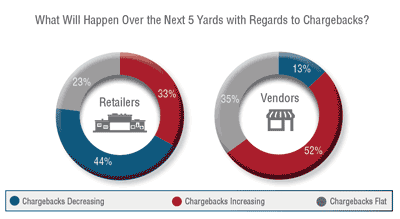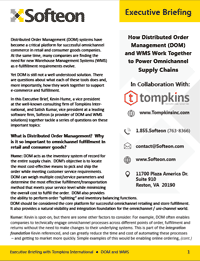 |
SUPPLY CHAIN NEWS BITES
|
Working Capital Performance Over Time 2017
|
|
 |
Demography is Destiny, and Right Now that Isn't Good
|
 |
Amazon Making More Moves in Mexico |
 |
Hurricane Harvey Hits August Manufacturing Output |
 |
Mixed Data on US Retail Sales Forecasts |
| |
|
|
| IMPORTANT RESEARCH |
The State of Retail and Vendor Supply Chain Relations 2017
|
|
Example Chart from 2015 Report

Are We Getting More Integrated and Collaborative -
Or Heading in the Other Direction? Help Needed from
Retailers and Vendors/Brand Companies. |
|

|
|
|
CARTOON CAPTION
CONTEST WINNERS
|
| August 9, 2017 Contest |

|
See Who Took Home the Prize!
|
|
|
|
|
|
|
Trip Report: enVista Fuel User Conference
enVista is among the more intriguing supply chain companies out there right now, with a truly unique mix of consulting services (e.g., WMS implementation, supply chain network design), other services such as a "freight pay and audit" offering, and (increasingly) its own software products (under its Inspire Commerce unit) that includes order management, EDI services, mobile point of sale and more, mostly focused on the retail sector.
enVista, under CEO Jim Barnes, has enjoyed rapid growth for a number of years.
It is extremely rare to almost the point of unheard of for a consulting firm to have a users conference the way software companies typically do each year, but enVista took the risk of such an event (called Fuel) just focused on its clients in the transportation area (consulting and freight pay/audit).
| SHERMAN SAYS: |
Rosier's primary point in the end was that traditional supply chain network design projects, even as they expand and become more of a continuous exercise, still leave lots of areas for improvement unexplored.
WHAT DO YOU SAY?
Send us your
Feedback here
|
It was a smart move, with some 75 companies coming to the Conrad Hotel in Chicago last week for the event, a very good number for an inaugural conference. I was there for one of the two days, leading a panel on omnichannel issues last Thursday, a discussion that was itself very good (see below) among solid content and presentations overall.
CSCMP CEO Rick Blasgen kicked off the event with an interesting review of highlights from the 2017 State of Logistics Report from CSCMP and lead authors AT Kearney.
I am very familiar with the data in the report, but still enjoyed the presentation from Blasgen. Highlights started with Blasgen's opening characterization of supply chain as the "shock absorber" between what is expected and what actually happens.
If you read SCDigest than you should know logistics costs actually fell to 7.5% of GDP in 2016, down a bit under half a percentage point from 2015 (a good thing) and well down from 8.6% in 2007.
But the US is well advantaged even versus Europe, where logistics costs are 13% of GDP, and China (18%). Blasgen noted in closing that supply chain's standing and credibility keeps rising in the view of executives.
In his keynote, enVista's Barnes noted the power of the digital transformation currently under way, asking attendees if they were thriving or just surviving in this brave new world, saying some savvy brick and mortar retailers are seeing strong total growth even as many seem beaten down by Amazon and ecommerce.
Barnes also made the point that an omnichannel inventory strategy cannot be developed in isolation, as it will be heavily dependent on how buyers actually do their jobs and what a company's inventory allocation processes are. "Digital is everything, but not everything is digital," Barnes noted as sort of an umbrella concept for his presentation.
He also predicts Amazon's Echo will soon be a huge new channel, with consumers just speaking orders into the device, especially for more commodity type products (e.g., paper towels).
My panel on omnichannel challenges featured Mike Starkey, VP of Information Systems at Performance Bike; Matt Arnold, director transportation and logistics at cosmetics maker and retailer Sephora USA; and Shannon Kohl, director of global transportation and trade for handbag and accessories maker Vera Bradley.
In some highlights of what was quite an interesting discussion from three very knowledgeable panelists, Kohl noted most Vera Bradley stores are east of the Mississippi, for which its single DC in Fort Wayne, IN has worked out well in providing two-day transit times. But now it gets on-line orders from the West Coast, and a week-long delivery cycle is no longer acceptable they way it was not long ago.
What to do? Vera Bradley is starting to do some fulfillment from a few stores that is has in Texas, and I assume also looking at other options in this new omnichannel world.
I briefly reviewed my omnichannel model that involves points of interaction (POIs), points of fulfillment (POFs) and points of return (PORs), and the need to determine which combinations of those need to be technically enabled.
|
 Starkey said Performance Bike went through a similar analysis, and came up with 11 of what it called "use cases" across its POIs, POFs and PORs, a number which jumped to 27 if you added in vendor drop ship. Starkey said Performance Bike went through a similar analysis, and came up with 11 of what it called "use cases" across its POIs, POFs and PORs, a number which jumped to 27 if you added in vendor drop ship.
I have made the point many times before that compared to most areas in supply chain, with omnichannel it really comes down to the technology. It's often binary - you can support a given process – say buy on-line, pick up in store – or you can't.
Did the panel agree with me that omnichannel challenges are largely technical? Yes and no. Starkey said "IT is foundational. If IT can't support it, then the rest of the organization can't step up and do their pieces and parts."
However, "In my experience, we got through the technology piece, but found that we underestimated the people part," he added, noting that getting stores managers and staff on-board with a ship from store model took a lot of change management, though he also said "Without the technology part you never get to the people part."
I can obviously agree with that, but Kohl was more in line with my original point. "It is all about IT," he said. "To make it happen [the process you want to support] the technology has to be the foundation," though he said Vera Bradley has found some manual workarounds in areas awaiting full technology support, at the cost of some inefficiency.
Arnold added "Technology is the foundation for sure. You have to be able to capture the order in some way, shape or form, and then move it through your system." However, Arnold said there are other issues that go beyond technology. For example, while technology is needed to manage inventory across channels, there are key strategic issues, such as whether store inventories are designed to be "shallow and wide, or narrow and deep" – and that decision obviously then impacts replenishment strategies, made more complicated by ship from store or order for store pick-up programs that can take inventory.
What is the biggest challenge each company has in omnichannel? Kohl said for Vera Bradley it is adjusting to constantly changing consumer buying behaviors. Specifically, what will operations look like if ecommerce becomes 50% of the company's business in a few years, a real possibility?
For Arnold, the biggest challenge relates to how the current teen generation especially is simply glued to their phones, and thus making it all about how you deal with mobile, i.e., how do you push info to consumers, best take mobile orders, create a mobile experience that drives them into the store? Behaviors and technology in this area are moving so fast, it is very difficult to keep up.
Starkey said the biggest challenge for Performance Bike has to do with customer service, which is harder to manage in terms of cycle time (no pun intended) and days to shipment when it is fulfilled by stores, versus the fast and consistent turnaround times when shipping bikes ordered in store or on-line for pick-up in store from the DC. As a side note on just how the world is changing, Starkey also said Performance will assemble a bike for free at their stores even if it was ordered and fulfilled by Amazon.com or one of Amazon's Marketplace vendors.
I am almost out of room and will have to leave two other good presentations I saw off this summary, but I heard a very interesting presentation from enVista's Nate Rosier on what he termed "product flow design." At first I thought and asked if this was basically "flow path optimization," an increasingly common practice, and the answer is there is some overlap but we are really talking about different approaches.
Rosier's primary point in the end was that traditional supply chain network design projects, even as they expand and become more of a continuous exercise, still leave lots of areas for improvement unexplored. That is because, he said, design tools cannot really get granular enough in terms of actual operating issues.
Rosier cited, for example, the case of one retailer dealing with huge operating challenges due to inventory overload in one DC in peak season. Turns out that retailer really knew little about the patterns and variability of its vendor inbound shipments. Greatly simplifying, the retailer increased effective capacity 27% by working to reduce lead time variation and late/early shipments, and staggering large inbound shipments into small "waves" using a pool point. More on all this soon.
A fine event by enVista, especially for being a debut. Good job by marketing chief J.J. Berrall and the rest of the team.
Any reaction to this trip report? Is it all about the technology in omnichannel? Do supply chain design tools not get granular enough in some area? Let us know your thoughts at the Feedback button below.
|

|
 |
|
| |
|
|
NEW Videocast: |
Supply Chain Optimization Predictions and Misses: A Look at Back at Optimization Trends in 2017 - Where We're Headed in 2018
|

|
A Look at How Events this Year Impacted Supply Chain Design and Optimization - and How You can Be Ahead of the Curve in 2018
A look at unforeseen events of 2017 - and how they impacted supply chain practice, as well as, a discussion in key trends that we can expect in optimization in 2018 and beyond.
Featuring LLamasoft EVP Toby Brzoznowski and Supply Chain Digest Editor Dan Gilmore.
|
 |
| Wednesday Oct. 11, 2017 |
|
On Demand Videocast: |
How DOM and WMS Work Together to Power Omnichannel Supply Chains
|
 |
Experts from Tompkins International and Softeon Set the Record Straight in Fast Paced, Q&A Format
This discussion will be based on an outstanding new "Executive Brief" on this same topic, developed jointly by Kevin Hume of Tompkins International and Satish Kumar, a vice president at Softeon.
Featuring SCDigest editor Dan Gilmore, Kevin Hume of well-known consulting firm Tompkins International and Satish Kumar, a vice president at Softeon.
|
 |
Available On Demand |
|
On Demand Videocast: |
New Cloud WMS Solution is Game Changer for Warehouse Management Deployment and Flexibility |

|
New Technology and Deployment Approach Offer a Simply Better Way to WMS Implementations - Learn How
In this outstanding Videocast, we will cover the latest in each-picking robotics, co-bots, artificial intelligence, autonomous vehicles, sensors, drones and droids.
Featuring Dan Gilmore, Editor, along with Mark Hawksley and Bruno Dubreuil of TECSYS, a leading provider of WMS solutions.
|
 |
| Available On Demand |
|
|



![]()
![]()

![]()










